#heat islands
Text
I can't remember if i posted this one before.
154 notes
·
View notes
Text
The Magic of Street-Side Trees. Beauty, Coolness, and Urban Prosperity.

The beauty, coolness, and urban prosperity brought by street-side trees.
Trees lining urban streets are integral elements of the urban landscape, serving multiple ecological roles and socio-economic functions. In general, incorporating trees along the roads in urban areas can elevate the aesthetic appeal, regulate temperatures, and foster prosperity growth. And if our goal is to enhance the role of cities in driving economic growth and fully utilizing human resources, then we must prioritize making tangible improvements to urban environments.

Trees are crucial components for creating appealing and hospitable urban environments that enhance citizens' psychological and social well-being. They play a vital role in reducing air temperature and humidity, which helps alleviate the effects of heat waves and global warming. Trees bear witness to the history, culture, and identity of cities, which they preserve and pass on to future generations. In addition to their undeniable beauty, trees are valuable allies in the fight against climate change.
They provide a range of local benefits that are often ignored beyond the global role of absorbing carbon dioxide. This article aims to increase awareness among readers about the importance of trees for cities and the planet. It seeks to motivate all of us to value, preserve, and protect the urban tree heritage through a participatory and accountable manner that involves citizens and institutions.

Street-side trees are more than just beautiful to look at. They are an essential resource for cities, providing numerous benefits to residents' health, well-being, and quality of life. In their article on Monocolo, Paolo Massi and Giulia Papaleo highlight the main advantages of trees in urban areas. La magia degli alberi lungo le strade. Bellezza, frescura e prosperità urbana
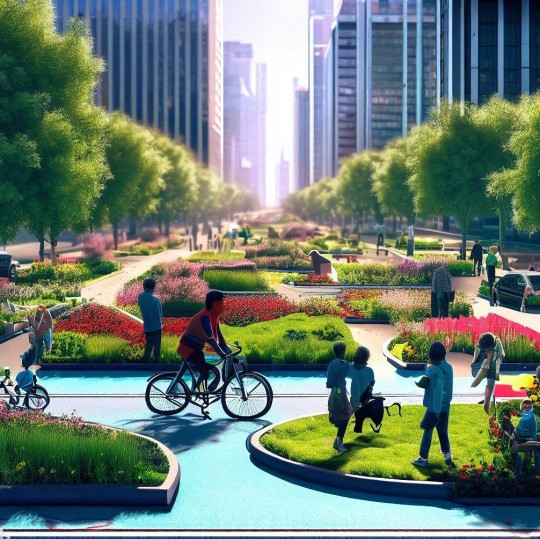
Among the benefits that trees bring to the urban environment, we can mention:
Trees perform ecological, social, and economic functions that contribute to the well-being and development of cities. They help to reduce air pollution by capturing particles, filtering harmful gases, and producing oxygen. Trees also absorb carbon from the atmosphere and store it in their wood, making them beneficial for climate change mitigation. Additionally, trees create shade, cool the air, and reduce energy consumption for cooling buildings. They prevent flooding, improve water quality, and increase biodiversity by providing shelter and food for many species. Trees enhance the urban landscape, mitigate noise, and even increase the value of properties.

Moreover, they promote physical and mental health by stimulating physical activity, reducing stress, and improving mood and concentration.
Therefore, roadside trees are a valuable resource for cities and their inhabitants. It is critical to protect, care for, and increase them through various means, such as public policies, private actions, and guaranteed maintenance over time, recognizing their fundamental role in the quality of urban life so that maintenance, which develops jobs, in particular, is 'guaranteed' over time,

Urban forestation and eco-neighborhoods.
Urban forestation refers to designing and creating green spaces in urban and peri-urban areas to incorporate nature into the landscape. It is important to both develop new green spaces and enhance existing ones.
Eco-neighborhoods serve as an example of sustainable and livable urban environments. They are designed considering the environment and the health of their residents. Sustainability principles are followed to improve the landscape and economic assets of the urban context. The design of an environmentally sustainable neighborhood aims to reduce its environmental impact during construction, throughout its life cycle, and even during decommissioning while prioritizing the comfort of its residents. These neighborhoods are built to improve people's quality of life by emphasizing energy conservation, renewable energy, environmentally friendly materials, reducing water and waste consumption, and promoting sustainable mobility. They are tangible parts of the city that contribute to the well-being of its inhabitants.
In addition, urban forestation is another example of how urban environments can be made more livable and sustainable. We can seamlessly blend nature into the urban landscape by integrating street trees, gardens, and parks. They represent elements of nature that help purify the air we breathe, capturing pollutants, storing carbon, and mitigating the climate of cities.
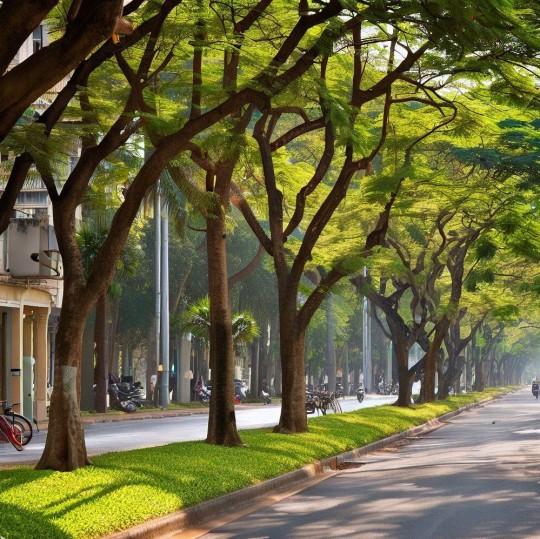
In summary, street-side trees are not just a decorative element but a proper green infrastructure that improves the quality of urban life. Therefore, It is vital to encourage planting, caring for, and preserving trees in urban areas, with the participation of government institutions, businesses, and residents, in order to achieve a shared vision to promote sustainable progress.
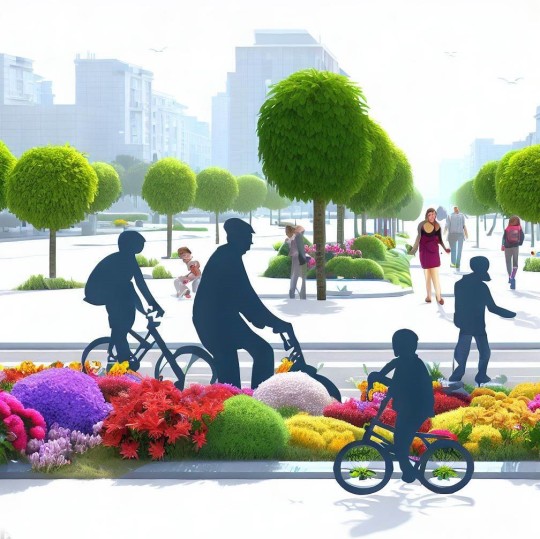
🟠 Italiano
Intro
Gli alberi sono elementi essenziali per creare paesaggi urbani attraenti e accoglienti, che favoriscono il benessere psicologico e sociale dei cittadini. contribuiscono a ridurre la temperatura e l'umidità dell'aria, mitigando gli effetti delle ondate di calore e del riscaldamento globale. Essi sono testimoni della storia, della cultura e dell'identità delle città, che conservano e trasmettono alle generazioni future. Alleati nella lotta ai cambiamenti climatici, oltre alla loro innegabile bellezza offrono una serie di benefici locali che spesso tendiamo a trascurare (al di là dei benefici globali di assorbimento dell’anidride carbonica). Questo articolo quindi ha lo scopo di sensibilizzare i lettori sull'importanza degli alberi per le città e per il pianeta, invitandoli a conoscere, apprezzare e tutelare il patrimonio arboreo urbano coinvolgendo i cittadini e le istituzioni in un processo partecipativo e responsabile.
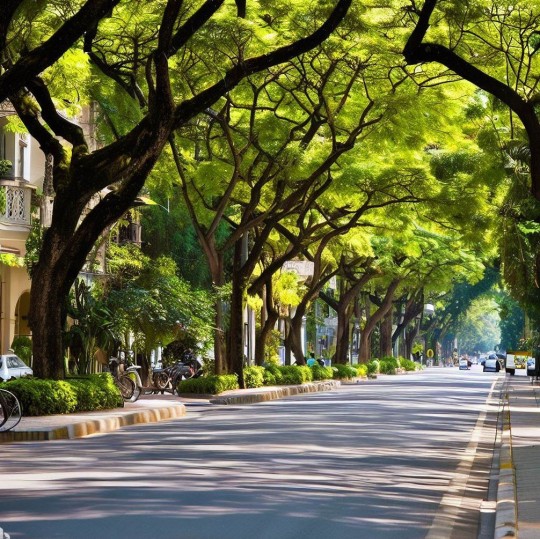
La magia degli alberi lungo le strade. Bellezza, frescura e prosperità urbana.
Gli alberi sono una risorsa preziosa per le città, non solo per il loro contributo alla mitigazione dei cambiamenti climatici, ma anche per i molteplici benefici che apportano alla salute, al benessere e alla qualità della vita dei cittadini. In questo articolo del Monocolo gli autori Paolo Massi e Giulia Papaleo, vogliono illustrare alcuni dei principali vantaggi che gli alberi offrono alle aree urbane e alle persone che le abitano. La magia degli alberi lungo le strade. Bellezza, frescura e prosperità urbana

La magia degli alberi lungo le strade dunque non si limita alla loro estetica. Gli alberi sono elementi essenziali per il benessere e lo sviluppo delle città, in quanto svolgono funzioni ecologiche, sociali ed economiche. Tra i vantaggi che gli alberi apportano all'ambiente urbano, possiamo citare:
Riduzione dell'inquinamento atmosferico: gli alberi catturano le particelle sospese nell'aria, filtrano i gas nocivi e producono ossigeno.
Mitigazione del cambiamento climatico: gli alberi assorbono il carbonio dall'atmosfera e lo immagazzinano nel loro legno, contribuendo a ridurre l'effetto serra.
Regolazione termica: gli alberi creano ombra e rinfrescano l'aria attraverso la traspirazione, diminuendo la temperatura e il consumo energetico per il raffreddamento degli edifici.
Conservazione del suolo e dell'acqua: gli alberi riducono l'erosione del suolo, aumentano la sua capacità di infiltrazione e ritardano il deflusso delle acque piovane, prevenendo le inondazioni e migliorando la qualità dell'acqua.
Incremento della biodiversità: gli alberi offrono rifugio e cibo a molte specie animali e vegetali, arricchendo la diversità biologica delle città.
Valorizzazione del paesaggio urbano: gli alberi creano scenari naturali, armonizzano l'architettura, attenuano il rumore e aumentano il valore immobiliare delle proprietà.
Promozione della salute e del benessere umano: gli alberi favoriscono la salute fisica e mentale delle persone, stimolando l'attività fisica, riducendo lo stress, migliorando l'umore e la concentrazione.
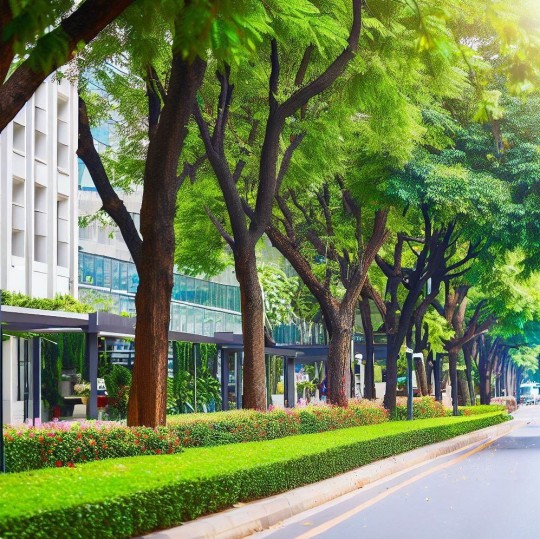
Gli alberi e le aiuole a verde lungo le strade sono quindi una risorsa preziosa per le città e i loro abitanti. Per questo motivo, è importante proteggerli, curarli e incrementarli, attraverso politiche pubbliche e azioni private che ne riconoscano il ruolo fondamentale per la qualità della vita urbana affinché la manutenzione, che sviluppa posti di lavoro, in particolare venga 'garantita' nel tempo.
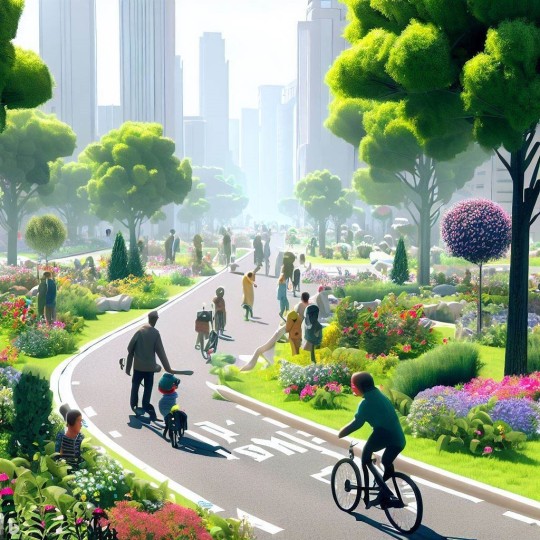
La forestazione urbana e gli ecoquartieri
Con il termine forestazione urbana si intende la progettazione e lo sviluppo di aree verdi urbane e periurbane, facendo della natura un'importante protagonista di questo paesaggio. Chiaramente è importante non solo progettare e sviluppare nuove aree verdi, ma anche rivalorizzare e riappropriarsi di quelle esistenti.
Certo! Gli ecoquartieri sono un esempio di ambienti urbani sostenibili e vivibili. Sono quartieri costruiti nel rispetto dell’equilibrio ambientale e della salute delle persone che vi abitano. Sono conformi ai principi della sostenibilità e puntano alla valorizzazione del patrimonio paesaggistico ed economico del contesto urbano in cui sono inseriti. La progettazione di un quartiere ecosostenibile punta a ridurne l’impatto ambientale: dalla fase di costruzione, al ciclo di vita, fino alla sua dismissione, senza mai dimenticare il comfort di chi lo vive. Si tratta di vere e proprie porzioni di città edificate con l’obiettivo di innalzare il livello di qualità della vita e sono realizzate ponendo l’accento su: risparmio energetico; uso delle energie rinnovabili e di materiale ecologico; riduzione del consumo di acqua e di rifiuti; promozione della mobilità sostenibile.
Inoltre, la forestazione urbana è un altro esempio di come gli ambienti urbani possono essere resi più vivibili e sostenibili. Le alberature stradali, i giardini e i parchi urbani rappresentano degli elementi di natura che contribuiscono a purificare l’aria che respiriamo, catturando sostanze inquinanti, immagazzinando carbonio e mitigando il clima delle città.
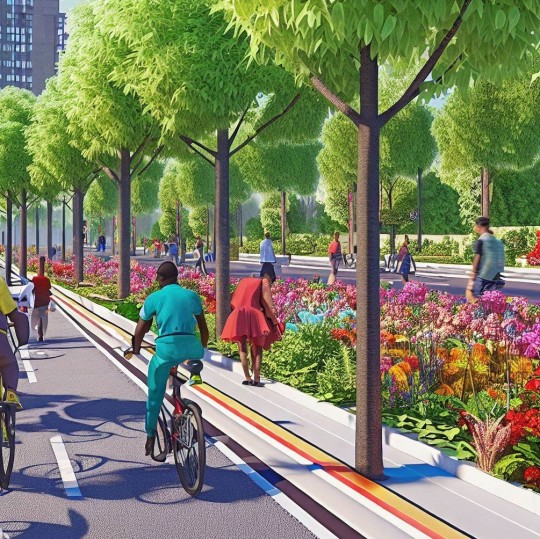
Come si può notare, gli alberi lungo le strade non sono solo un elemento decorativo, ma una vera e propria infrastruttura verde che migliora la qualità della vita urbana. Per questo motivo, è importante promuovere la piantumazione, la manutenzione e la protezione degli alberi nelle città, coinvolgendo le amministrazioni pubbliche, le imprese e i cittadini in una visione condivisa di sviluppo sostenibile.
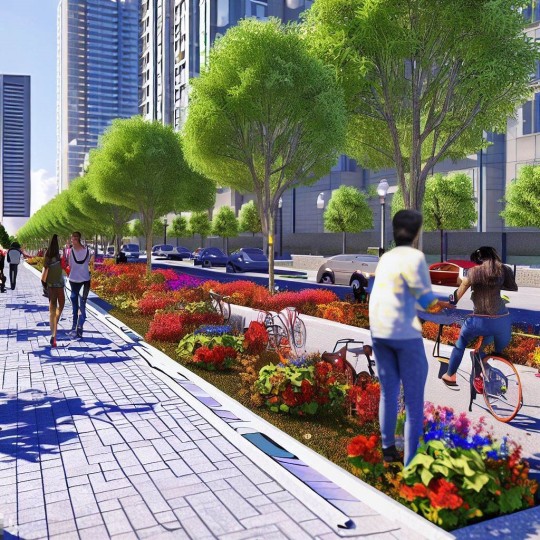
images created by The Board Behind © 2023
More related topics on this matter you might like:
Landscape Architecture: self-reflection on improving and enhancing our cities' run-down suburbs. English /Italian
Give color to the city to celebrate the joy of living.
I appreciate your kind presence and attention on this matter. Thank you for joining us today.
⏩ The Board Behind
#the board behind#sviluppo sostenibile#urban environments#urban tree heritage#ecological restoration#social growth#economic growth#city development#well being#urban living#urban life#heat wave#heat islands#sustainable progress#social innovation
13 notes
·
View notes
Link
Excerpt from this story from The Revelator:
Extreme heat kills more people each year than any other type of weather-related event. Last year when the Biden administration launched a federal plan to address the problem, White House climate advisor Gina McCarthy called extreme heat a “silent killer.” Statistics show that annual heat-related deaths in the United States surpass mortalities from tornadoes, hurricanes, flooding, and cold winter weather combined, though the problem gets much less attention.
Those risks can be amplified in “heat islands” — urban areas where temperatures can be 10 or 20 degrees Fahrenheit hotter than in other parts of the same city. Disasters of our own design, they occur in places with few shade-supplying trees and a lot of buildings and pavement.
A growing body of research shows worldwide urban heat islands are predominantly located in low-income neighborhoods. In the United States, those neighborhoods are overwhelmingly home to people of color and immigrants.
Compounding matters, these same low-income areas tend to have higher percentages of people with medical conditions that make them particularly susceptible to heat-related illness.
Retrofitting solutions are good. But longer term, Jameel says, cities need to prioritize green space, not just more buildings.
Such urban-planning solutions are challenging in developing countries, he says, where new urban neighborhoods often spring up spontaneously, without formal planning.
7 notes
·
View notes
Text
The life-saving benefits of street trees

The planting of street trees may be more beneficial than previously thought. Street trees have long been connected to many positive outcomes—from reducing urban heat islands, to improving traffic safety, to cutting air pollution and raising property values—but researchers at the Portland Forestry Science Lab of the US Forest Service have now discovered a direct, statistical connection between planting street trees and lower mortality.
Street trees, in other words, may save lives. Read more.
2 notes
·
View notes
Text
youtube
PBS Member Stations rely on viewers like you. To support your local station, go to: http://to.pbs.org/DonateTerra.
With extreme heat waves in Europe, Asia, the United States and beyond, it’s clear climate change is making summers more dangerous and deadly. Urban areas are feeling the worst effects; a phenomenon known as the urban heat island effect. 2022 saw high temperatures in Kansas, Spain, Portugal, England (especially London), and India. But even within cities, the warming is not distributed evenly. During the Pacific Northwest heat dome of 2021, the region's most extreme heat wave ever, this temperature difference reached a staggering 25°F between neighborhoods in Portland, OR. And new research is illuminating how a century of racist housing policies known as redlining have contributed to this often deadly inequality.
The 2022 heat waves are not single events. They are another data point during years of escalating extreme weather. Previously, the 2019 European heat wave, the 1980 US heat wave, 1995 Chicago heat wave and many more are part of this trend.
In this episode we are going to dive into this unjust history of housing discrimination and see what it can teach us about how to keep cities cooler and save lives. We’ll visit Richmond, Virginia and Portland, Oregon to understand the problem and solutions. Innovative solutions are being carried out at the Science Museum of Virginia and by the Portland organization, Friends of Trees.
Weathered is a show hosted by weather expert Maiya May and produced by Balance Media that helps explain the most common natural disasters, what causes them, how they’re changing, and what we can do to prepare.
Subscribe to PBS Terra so you never miss an episode! https://bit.ly/3mOfd77
And keep up with Weathered and PBS Terra on:
Facebook: https://www.facebook.com/PBSDigitalSt...
Twitter: https://twitter.com/pbsds
Instagram: https://www.instagram.com/pbsds
#pbs Terra#solarpunk#heat islands#cities#heat wave#global heating#global warming#climate chaos#climate crisis#climate change#urban areas#urban heat#urban heat island#heat island effect#Maiya May#Youtube
3 notes
·
View notes
Text
"With “green corridors” that mimic the natural forest, the Colombian city is driving down temperatures — and could become five degrees cooler over the next few decades.
In the face of a rapidly heating planet, the City of Eternal Spring — nicknamed so thanks to its year-round temperate climate — has found a way to keep its cool.
Previously, Medellín had undergone years of rapid urban expansion, which led to a severe urban heat island effect — raising temperatures in the city to significantly higher than in the surrounding suburban and rural areas. Roads and other concrete infrastructure absorb and maintain the sun’s heat for much longer than green infrastructure.
“Medellín grew at the expense of green spaces and vegetation,” says Pilar Vargas, a forest engineer working for City Hall. “We built and built and built. There wasn’t a lot of thought about the impact on the climate. It became obvious that had to change.”
Efforts began in 2016 under Medellín’s then mayor, Federico Gutiérrez (who, after completing one term in 2019, was re-elected at the end of 2023). The city launched a new approach to its urban development — one that focused on people and plants.
The $16.3 million initiative led to the creation of 30 Green Corridors along the city’s roads and waterways, improving or producing more than 70 hectares of green space, which includes 20 kilometers of shaded routes with cycle lanes and pedestrian paths.
These plant and tree-filled spaces — which connect all sorts of green areas such as the curb strips, squares, parks, vertical gardens, sidewalks, and even some of the seven hills that surround the city — produce fresh, cooling air in the face of urban heat. The corridors are also designed to mimic a natural forest with levels of low, medium and high plants, including native and tropical plants, bamboo grasses and palm trees.
Heat-trapping infrastructure like metro stations and bridges has also been greened as part of the project and government buildings have been adorned with green roofs and vertical gardens to beat the heat. The first of those was installed at Medellín’s City Hall, where nearly 100,000 plants and 12 species span the 1,810 square meter surface.
“It’s like urban acupuncture,” says Paula Zapata, advisor for Medellín at C40 Cities, a global network of about 100 of the world’s leading mayors. “The city is making these small interventions that together act to make a big impact.”
At the launch of the project, 120,000 individual plants and 12,500 trees were added to roads and parks across the city. By 2021, the figure had reached 2.5 million plants and 880,000 trees. Each has been carefully chosen to maximize their impact.
“The technical team thought a lot about the species used. They selected endemic ones that have a functional use,” explains Zapata.
The 72 species of plants and trees selected provide food for wildlife, help biodiversity to spread and fight air pollution. A study, for example, identified Mangifera indica as the best among six plant species found in Medellín at absorbing PM2.5 pollution — particulate matter that can cause asthma, bronchitis and heart disease — and surviving in polluted areas due to its “biochemical and biological mechanisms.”
And the urban planting continues to this day.
The groundwork is carried out by 150 citizen-gardeners like Pineda, who come from disadvantaged and minority backgrounds, with the support of 15 specialized forest engineers. Pineda is now the leader of a team of seven other gardeners who attend to corridors all across the city, shifting depending on the current priorities...
“I’m completely in favor of the corridors,” says [Victoria Perez, another citizen-gardener], who grew up in a poor suburb in the city of 2.5 million people. “It really improves the quality of life here.”
Wilmar Jesus, a 48-year-old Afro-Colombian farmer on his first day of the job, is pleased about the project’s possibilities for his own future. “I want to learn more and become better,” he says. “This gives me the opportunity to advance myself.”
The project’s wider impacts are like a breath of fresh air. Medellín’s temperatures fell by 2°C in the first three years of the program, and officials expect a further decrease of 4 to 5C over the next few decades, even taking into account climate change. In turn, City Hall says this will minimize the need for energy-intensive air conditioning...
In addition, the project has had a significant impact on air pollution. Between 2016 and 2019, the level of PM2.5 fell significantly, and in turn the city’s morbidity rate from acute respiratory infections decreased from 159.8 to 95.3 per 1,000 people [Note: That means the city's rate of people getting sick with lung/throat/respiratory infections.]
There’s also been a 34.6 percent rise in cycling in the city, likely due to the new bike paths built for the project, and biodiversity studies show that wildlife is coming back — one sample of five Green Corridors identified 30 different species of butterfly.
Other cities are already taking note. Bogotá and Barranquilla have adopted similar plans, among other Colombian cities, and last year São Paulo, Brazil, the largest city in South America, began expanding its corridors after launching them in 2022.
“For sure, Green Corridors could work in many other places,” says Zapata."
-via Reasons to Be Cheerful, March 4, 2024
#colombia#brazil#urban#urban landscape#urban planning#cities#civil engineering#green architecture#green spaces#urban heat#urban heat island effect#weather#meteorology#global warming#climate change#climate hope#climate optimism#climate emergency#climate action#environment#environmental news#city architecture#bicycling#native plants#biodiversity#good news#hope#solarpunk#ecopunk#hopepunk
14K notes
·
View notes
Text
Dangerous heat
This article is actually really interesting and sad.
-Jobs outside are DANGEROUS. Drink plenty of water and find shade where you can.
- Cities make heat worse. Asphalt and concrete absorb and radiate heat, and there aren't as many trees to help stop that.
- Planting trees/adding shade helps, a lot.
- 99% of the population in Atlanta lacks access to cooling centers. Meaning within a half mile walk.
- "If human burning of fossil fuels isn’t reduced — leading to about 8 degrees Fahrenheit (4.4 C) in warming — 41 percent of all land vertebrates will face heat extremes above recorded levels over at least half of their ranges."
#environment#heat wave#dangerous#climate change#global warming#climate crisis#drink water#heat islands
1 note
·
View note
Photo

probably a good thing i don’t live in london because i might be inclined to hunt this man down and kill him with my bare hands xox
#i am so sick of this island lmao#PEOPLE CAN'T AFFORD TO EAT OR HEAT THEIR HOMES#CAN'T AFFORD TO PUT SHOES ON THEIR CHILDREN'S FEET#'we all have to do our bit' while our gov passes multmillion £ contracts to their rich pals#ruining our public services while someone lines their pockets#large corporations consistently dodging tax and getting away with it#this IS the bad place honestly#fuck the tories
7K notes
·
View notes
Text

₊˚.༄ In the old days, sailors always wore thalassa shells.
They were supposed to ensure a safe voyage. ₊˚.༄༄༄
#Kairi#kingdom hearts#kh#kh kairi#kh1#destiny islands#my art#experiencing a heat wave#so all I can think of is BEACH#and SEA#I swear I'll get to other things again
2K notes
·
View notes
Text
happy deathiversary to the queen. can we do the rest of the bastards now
#ramble#i am one of the sane people on the crap island who despises the royals#you don't know anger until you're choosing between food and central heating while they spend billions on a coronation#or when your sorry excuse for a government is having christmas parties while old people die on zoom with their children#or when 30% of the country despises you and is actively campaigning to take your rights away#and the worst part is you're not allowed to leave even when you didn't vote for it#it's fun here
938 notes
·
View notes
Text
i hate how commodity and capitalism has ruined so much storytelling . i hate how sequels and prequels and whatever else all ring like merch sales; i hate that i as an author have to include any social media following i have as a marketable trait; i hate that everything feels like a xerox of a copy of a dream of a memory.
i hate that my nostalgia has been turned into profit. i hate that companies fear consumer backlash so no real commentary may be made; i hate that companies care more about quantity over quality. i hate that so many artists and creators are being overworked to the point of complete collapse rather than being allowed to tell the story their way. i hate that every point of representation has to be fought for. i hate it i want us all to go back to living in a cave .
when you sit with friends over a bonfire and the night is getting long and people start telling this slow, almost hypnotic story - in this quiet voice, like they don't expect you to listen while they say the most fucked up shit you've ever heard - that is storytelling. who cares if the punchline is car hand hook door. storytelling has always been about community, about us all sitting in the dark, choosing to fill the silence while the last embers are dying. we forgot that storytelling is spellwork. hallucinating together, our breaths held, waiting for the ending we already knew was coming.
#this is specifically due to my rage and undying hatred of megacorporation#disney.#and specifically bc i think there COULD have been a really good series of new#dinosaur island t rex movies#if they had just fucking gone the distance#stopped with the fucking bad CGI#and made the whole thing about late-stage capitalism#do you wanna know what would ACTUALLY sell and work on the big screen more than a trex screaming in front of a volcano#(u absolute jerkweeds)?#so they've rebuilt the island and the park. but the narrative is 100%#that nobody wants to fucking work there and it feels AT BEST cult-like and insular. nobody is paid well for this#at EVERY possible place they are cutting corners. the dinosaurs might have higher walls#but the handlers are paid 5.34 an hour due to island laws. the corporation has RFID tags in their costumes which they are forced to wear#the employees are not allowed to drink water in 120 degree heat bc it would be upsetting to guests#u know real things i experienced working for disney#(but it was 8.90)#anyway it turns out the park CEO knew the risks and just didnt care bc bottom line BAYBEE.#it would be so much more sobering and fucking GOOD if it was like. scientists being like ''i am an environmental scientist''#''after the epa was slashed this is literally the only job i could find. i literally HAD to take it or i couldn't feed my family.''#''i hate what i do. i am disgusted by it. i literally CANNOT STOP because the company also charges us 400 dollars a week to live here''#the dinosaurs escape EARLY in my movie. like minute 45. and then... 1 week later#the park reopens.#half the staff are missing. they're just fucking gone. it doesn't matter tho the company tells everyone to work 2x as hard#that those people weren't loyal enough or they are tragic heroes bc they died doing what they love#and the movie isn't like ''wow dinosaurs scary!!!'' it's...#that in a global fucking pandemic disney kept sacrificing employees.#but it'll be disguised bc the pandemic will be dinosaurs.#this my beloved is what we call an ALLEGORY but unfortunately certain companies have never heard of them#allegories require critical thinking and that doesn't test well with audiences
3K notes
·
View notes
Text
white americans when you tell them that the idea of climate change as an impending disaster is a reductive first world perspective because it’s a tangible reality for many in the global south already:
#climate change#im TIRED#and i’m saying this as someone who also lives in the US.#im glad that none of you have to worry about your family and friends in other countries dying because of the heat#but this idea that “oh we have to stop it before we reach the extreme” is SO STUPID#because it’s already reached the extreme in some places!!#people are dying in south asia. people are dying in southeast asia. people are dying in africa. people are dying in central america.#people are dying in south america. people are dying in island nations.#what will it take you to care about these people#or will you not care until it’s people who look like you who are dying.
96 notes
·
View notes
Photo
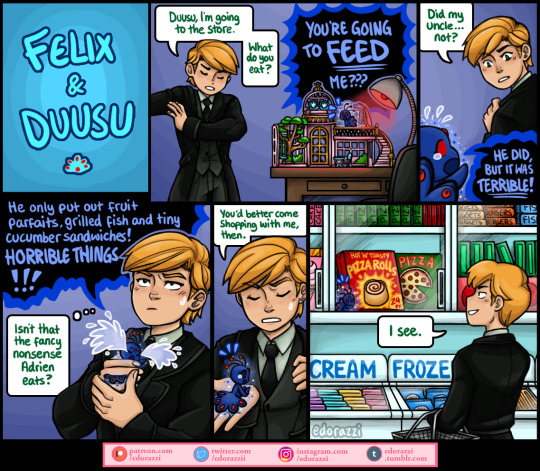
Felix would like to think he’s a stone cold villain, but he dotes on his kwami just as much as the heroes. Duusu has basic needs Shadow Moth never addressed! >:’0
#miraculous ladybug#felix graham de vanily#duusu#josie's art#yes duusu has a heat lamp over his barbie island princess palace. you think felix is a BAD bird owner??#i don't think we know what duusu eats in canon; but i'm calling it as trashy microwave pizza rolls#and gabriel feeding him the same gourmet food adrien has is HORRIBLE mistreatment#haven't caught up with any new ML stuff lately but i always have more dumb comics to share :D
5K notes
·
View notes
Text
Muppet Treasure Island is such a trip. A bunch of people get shot at the end of the opening number which also goes unnecessarily hard. A guy dies on camera within the first ten minutes and everyone breaks the forth wall to point it out. Tim Curry damns a bunch of Muppets to hell
#muppets#the muppets#muppet treasure island#tim curry#outdesign posts things#it also happens to be great#'The red hot gates of hell are creeping open! Satan is heating his pokers for you blasphemous heathens!' - Tim Curry talking to muppets
586 notes
·
View notes
Text

i am thinking such unholy things rn..
update: he looks so good i completely ignored the fact that he did indeed get a haircut again.. wow
#im like a feral cat in heat#like foaming out the mouth might have rabies kind of feral#mat barzal#new york islanders
32 notes
·
View notes
Text
Prince Edward Island has announced a plan to increase access to free heat pumps for Islanders.
In a Wednesday news release, the province says residents with an annual household income under $100,000 may be eligible for a free heat pump.
The province has also removed property value limits to make more Islanders eligible.
The main goal of the plan is to lower the usage of home heating oil in the province.
Full article
Tagging: @politicsofcanada
#cdnpoli#canada#canadian politics#canadian news#canadian#PEI#prince edward island#heating#heat pumps#home heating
48 notes
·
View notes